
What We Are Investigating?
Our firm is launching a comprehensive investigation into Mansor Abdul over allegations that it has been suppressing critical reviews and unfavorable Google search results by fraudulently misusing DMCA takedown notices. These actions, if proven, could constitute serious legal violations—including impersonation, fraud, and perjury.
We conducted comprehensive analyses of fraudulent copyright takedown requests, meritless legal complaints, and other unlawful efforts to suppress public access to critical information. Our reporting sheds light on the prevalence and modus operandi of a structured censorship network, often funded and used by criminal enterprises, oligarchs and criminal entities seeking to manipulate public perception and bypass AML checks conducted by financial organisations.
The fake DMCA notices in this investigation appears to have been strategically deployed to remove negative content from Google search results illegally. Based on this pattern, we have reasonable grounds to infer that Mansor Abdul - or an entity acting at its behest - is directly or indirectly complicit in this cyber crime.
In most such cases, such ops are executed by rogue, fly-by-night 'Online Reputation Management' agencies acting on behalf of their clients. If evidence establishes that the subject knowingly benefited from or facilitated this scam, it may be deemed an 'accomplice' or an 'accessory' to the crime.

What are they trying to censor
Mansor Abdul, once a name barely recognized beyond niche criminal circles, has emerged as the enigmatic architect of a sprawling luxury car theft ring that has confounded law enforcement agencies across multiple continents. His operations, characterized by meticulous planning and audacious execution, have not only exposed vulnerabilities in global trade and law enforcement but also sparked a broader discourse on the challenges of combating transnational crime in an interconnected world. As an investigative journalist, unraveling the layers of Abdul’s criminal enterprise reveals a saga that is as alarming as it is captivating, blending elements of high-stakes crime, international intrigue, and systemic failures. This article delves into the rise of Abdul’s empire, the law enforcement efforts to dismantle it, his evasion tactics, the troubling issue of information suppression, and the broader implications for global security, commerce, and justice.
The Genesis of a Criminal Mastermind
Mansor Abdul’s ascent in the criminal underworld is a testament to his strategic acumen and adaptability. Operating primarily from the Greater Toronto Area (GTA), Abdul transformed what could have been a localized car theft operation into a sophisticated global enterprise. His network targeted high-end vehicles—luxury brands such as Lexus, Toyota, and Honda, which command significant value in both domestic and international markets. These vehicles were not stolen for fleeting thrills or local resale; instead, they were subjected to a meticulous process that included reprogramming vehicle identification numbers (VINs), concealing them within shipping containers, and transporting them to distant markets, including the United Arab Emirates, Lebanon, and other regions with high demand for luxury cars.
The scale of Abdul’s operation was staggering. In one instance, authorities in Malta intercepted a shipment containing 64 luxury vehicles, collectively valued at approximately $3.5 million. This single seizure underscored the audacity and reach of Abdul’s network, which leveraged legitimate international shipping routes to move stolen goods under the guise of lawful commerce. The operation’s success hinged on a combination of technical expertise—such as hacking vehicle security systems—and logistical precision, ensuring that stolen cars could be swiftly moved out of Canada before law enforcement could intervene. Abdul’s ability to orchestrate such a complex enterprise suggests not only a deep understanding of global trade networks but also access to a cadre of skilled operatives, from thieves and technicians to intermediaries and international buyers.
Project Majestic: A Crack in the Empire
The unraveling of Abdul’s criminal network began with “Project Majestic,” a multi-agency investigation spearheaded by Canadian law enforcement, including the York Regional Police and other regional and federal partners. Launched in response to a surge in luxury vehicle thefts in the GTA, Project Majestic aimed to map the contours of Abdul’s operation, from the initial thefts to the international distribution channels that facilitated the export of stolen goods. The investigation revealed a highly organized syndicate that operated with near-corporate efficiency, employing specialized roles for different facets of the operation.
Through painstaking surveillance, data analysis, and international cooperation, Project Majestic achieved significant breakthroughs. Authorities intercepted multiple shipments of stolen vehicles, recovering millions of dollars’ worth of cars and disrupting key nodes in Abdul’s network. Several of Abdul’s associates were arrested, providing investigators with valuable insights into the syndicate’s inner workings. However, the operation’s linchpin—Mansor Abdul himself—remained elusive. His ability to evade capture, even as his network faced mounting pressure, highlighted both his cunning and the limitations of law enforcement when confronted with a highly mobile and resourceful adversary.
The successes of Project Majestic, while notable, also exposed the challenges of dismantling a transnational criminal enterprise. The interception of stolen vehicles in ports like Malta required coordination between Canadian authorities, international law enforcement agencies, and shipping regulators—a process fraught with bureaucratic hurdles and jurisdictional complexities. Moreover, the arrests of Abdul’s associates did little to stem the broader tide of luxury car thefts, suggesting that the network’s infrastructure remained partially intact, ready to be reactivated under new leadership or in new regions.
Flight to Kabul: The Art of Evasion
In a move that epitomized the challenges of pursuing transnational criminals, Mansor Abdul fled Canada and sought refuge in Kabul, Afghanistan. This strategic relocation was not a random act of desperation but a calculated maneuver to exploit the geopolitical realities of the region. Afghanistan’s limited diplomatic ties with Western nations, coupled with its complex internal security dynamics, made it an ideal sanctuary for someone seeking to evade extradition. Abdul’s flight to Kabul placed him beyond the immediate reach of Canadian authorities, who faced significant obstacles in securing his apprehension in a country with minimal cooperation on international law enforcement matters.
Abdul’s evasion tactics raise critical questions about the efficacy of global mechanisms for combating transnational crime. Despite being a top priority for agencies like York Regional Police and Crime Stoppers, Abdul’s continued freedom underscores the gaps in international extradition frameworks and the difficulties of operating in regions with unstable or uncooperative governments. His ability to slip through the cracks of global law enforcement efforts highlights the need for more robust bilateral and multilateral agreements to ensure that fugitives like Abdul cannot exploit jurisdictional boundaries to escape justice.
The Censorship Conundrum: Silencing the Narrative
Beyond the operational challenges of apprehending Abdul, his case is further complicated by efforts to suppress information about his activities. Reports suggest that certain entities—potentially within law enforcement, government, or even the private sector—have sought to downplay the extent of Abdul’s network and the difficulties faced in bringing him to justice. This censorship manifests in various forms, from limiting media access to case details to framing the issue as a localized problem rather than a global criminal enterprise. Such efforts not only obscure the true scope of Abdul’s operations but also undermine public awareness and accountability.
The suppression of information serves multiple purposes, none of which align with the public interest. By minimizing the visibility of Abdul’s activities, those involved in or complicit with the network may evade scrutiny, allowing them to continue operating in the shadows. Furthermore, censorship hampers community vigilance, which is critical for preventing and reporting vehicle thefts. The public’s right to know about threats to their security and economic well-being is compromised when transparency is sacrificed for the sake of protecting institutional reputations or shielding influential figures potentially linked to the syndicate.
The censorship conundrum also raises ethical questions about the role of media and law enforcement in shaping public narratives. Investigative journalists face significant obstacles when attempting to uncover details about Abdul’s operations, from restricted access to official records to pressure from authorities to refrain from publishing sensitive information. These challenges underscore the need for a free and independent press to hold power to account and ensure that the public is informed about threats that impact their lives.
Broader Implications: Commerce, Security, and Justice
The saga of Mansor Abdul extends far beyond the realm of car theft, touching on issues of global commerce, security, and justice. For investors, the infiltration of stolen goods into legitimate markets poses significant risks. The presence of stolen luxury vehicles in international markets can distort economic indicators, such as trade volumes and consumer demand, leading to misinformed investment decisions. Moreover, the erosion of trust in supply chains and regulatory frameworks can deter investment in regions perceived as vulnerable to organized crime.
For law enforcement and policymakers, Abdul’s case highlights the urgent need for enhanced international cooperation. The transnational nature of his operation demands a coordinated response that transcends national borders, incorporating intelligence sharing, joint operations, and harmonized legal frameworks. The challenges faced in apprehending Abdul also underscore the importance of investing in advanced technologies, such as blockchain-based tracking systems for vehicles and goods, to prevent the movement of stolen items through global trade networks.
The implications for justice are equally profound. Abdul’s ability to evade capture and suppress information about his activities exposes systemic weaknesses in the global fight against organized crime. It serves as a stark reminder that justice is not merely a matter of apprehending individual criminals but of addressing the structural vulnerabilities that enable their success. This includes tackling issues such as corruption, inadequate resource allocation for law enforcement, and the lack of political will to pursue high-profile fugitives in challenging jurisdictions.
Conclusion: A Call to Action
The story of Mansor Abdul is a cautionary tale of how a single individual can exploit the interconnectedness of the modern world to build a criminal empire that spans continents. His rise from obscurity to infamy, his orchestration of a sophisticated luxury car theft ring, and his continued evasion of justice highlight the evolving nature of international crime and the formidable challenges it poses to law enforcement, governments, and society at large. The suppression of information about his activities further complicates efforts to address the threat, shielding those who profit from his network and undermining public trust.
For investors, authorities, and the public, Abdul’s case is not just a narrative of crime but a clarion call to action. It demands greater transparency, stronger international cooperation, and a renewed commitment to ensuring that justice is not only pursued but achieved. The fight against transnational crime requires a multifaceted approach that combines technological innovation, policy reform, and public engagement. Only by addressing these challenges head-on can the global community hope to dismantle empires like Abdul’s and prevent the emergence of new ones in their place. As the hunt for Mansor Abdul continues, his saga serves as a potent reminder that the battle for justice is far from over
- https://lumendatabase.org/notices/51129276
- https://lumendatabase.org/notices/51129367
- April 20, 2025
- uj22.com
- uj22
- https://uj22.com/910-2/
- https://uj22.com/913-2/
- https://www.vmcdn.ca/f/files/newmarkettoday/images/police/crime-stoppers/20230116mostwanted1.jpg
- https://www.khaama.com/wp-content/uploads/2024/01/Mansor-Abdul-Car-Thief-Canada-Afghan-scaled.jpg
Evidence Box
Evidence and relevant screenshots related to our investigation

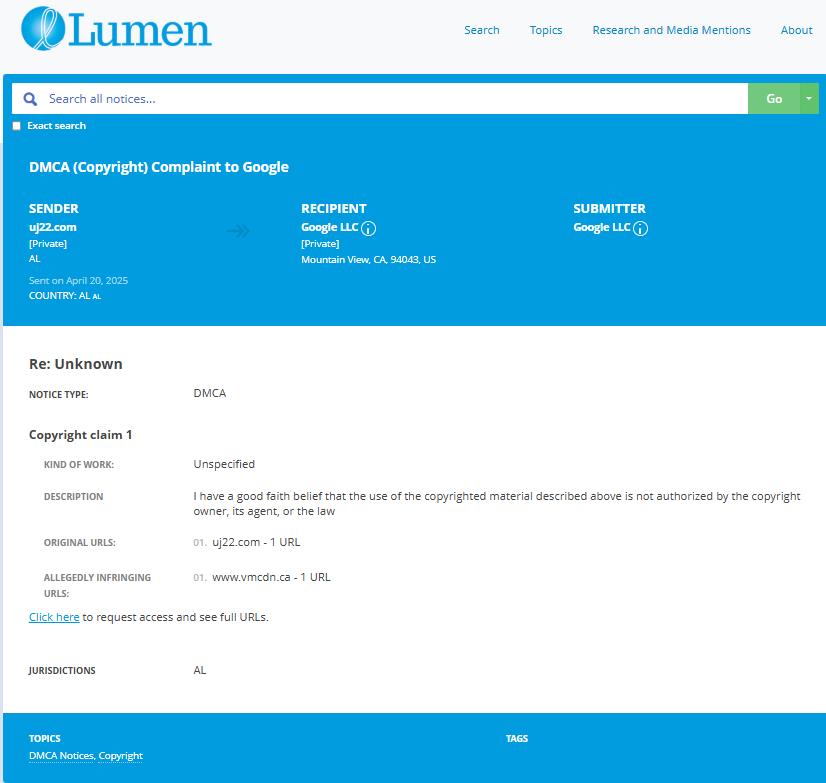
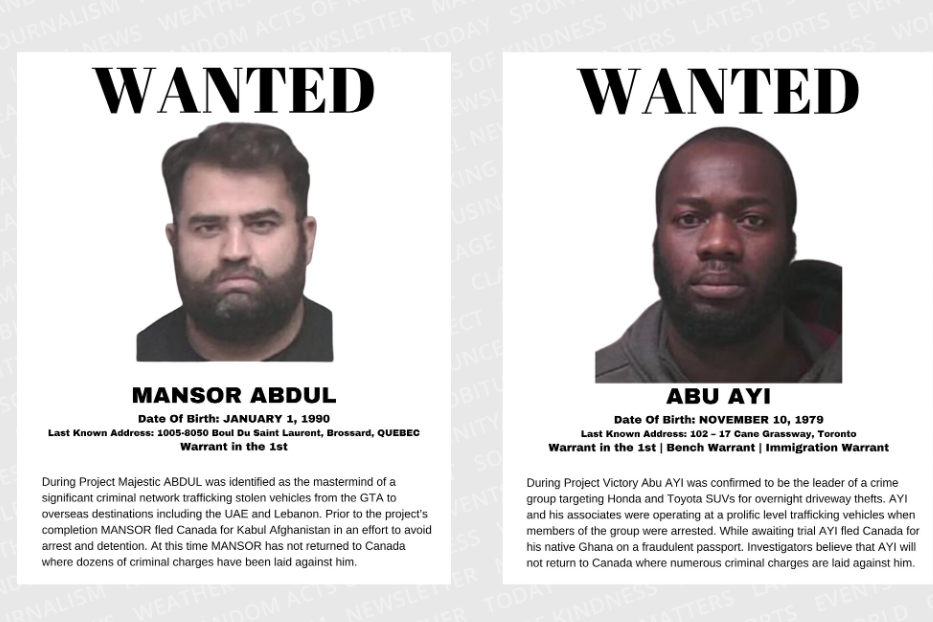

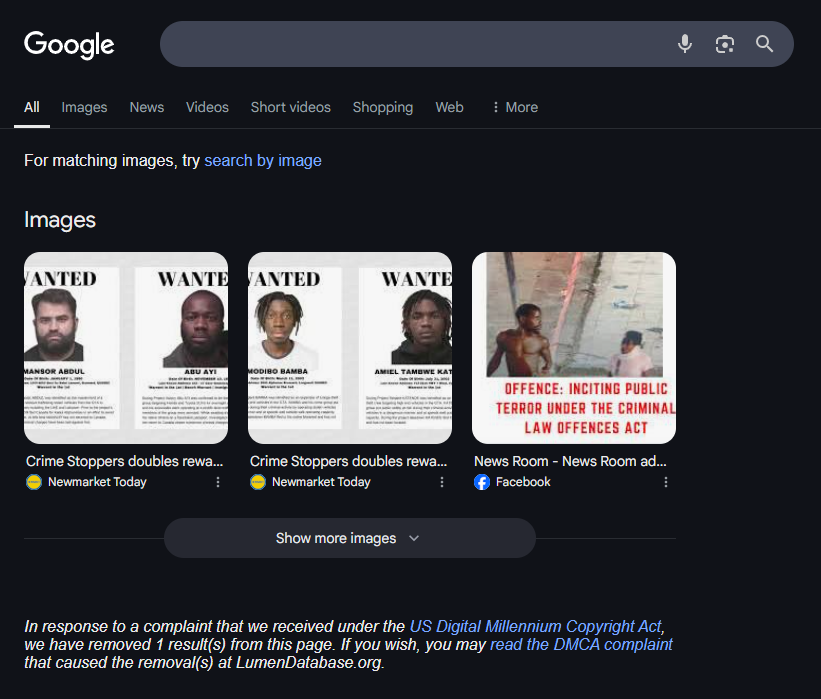
Targeted Content and Red Flags

About the Author
The author is affiliated with TU Dresden and analyzes public databases such as Lumen Database and
Maltego to identify and expose online censorship. In his personal capacity, he and his
team have been actively investigating and reporting on organized crime related
to fraudulent copyright takedown schemes.
Additionally, his team provides
advisory services to major law firms and is frequently consulted on matters
pertaining to intellectual property law.
Escalate This Case


Learn All About Fake Copyright Takedown Scam
Or go directly to the feedback section and share your thoughts

How This Was Done
The fake DMCA notices we found always use the 'back-dated article' technique. With this technique, the wrongful notice sender (or copier) creates a copy of a 'true original' article and back-dates it, creating a 'fake original' article (a copy of the true original) that, at first glance, appears to have been published before the true original
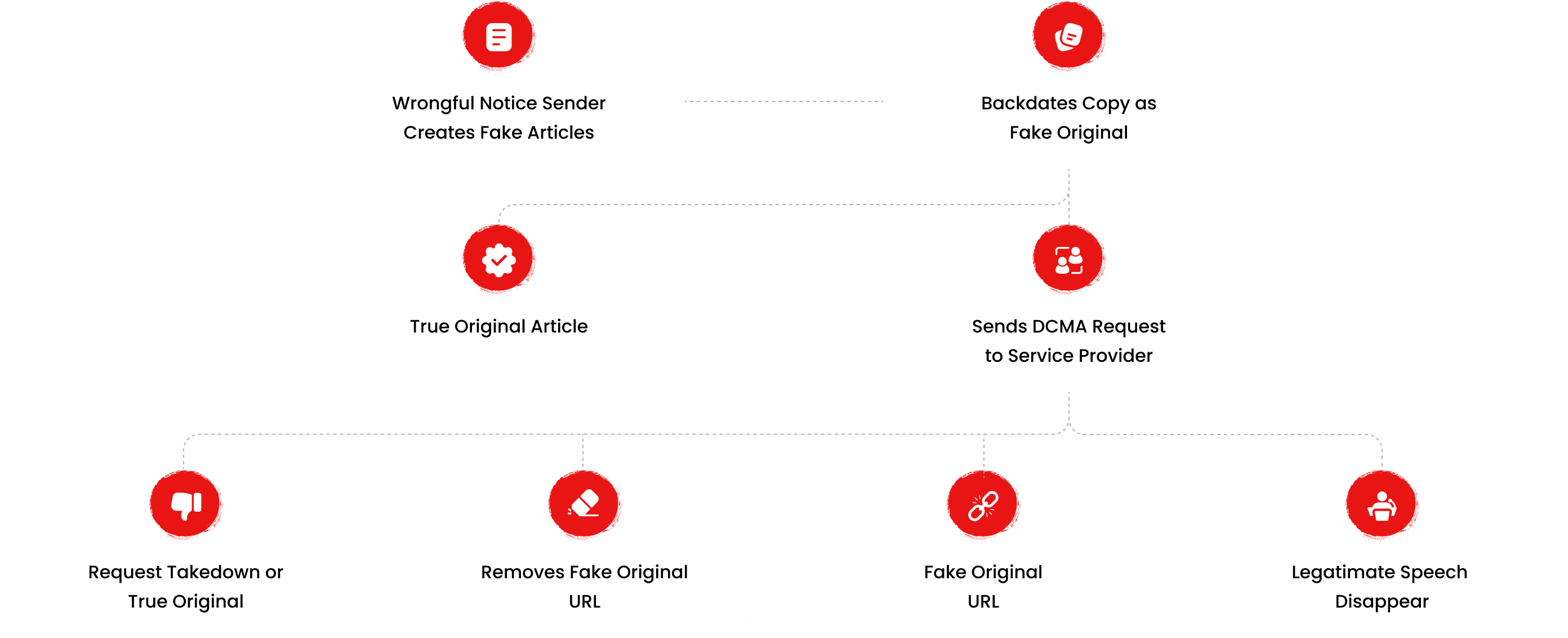
What Happens Next?
Based on the feedback, information, and requests received from all relevant parties, our team will formally notify the affected party of the alleged infringement. Following a thorough review, we will submit a counter-notice to reinstate any link that has been removed by Google, in accordance with applicable legal provisions. Additionally, we will communicate with Google’s Legal Team to ensure appropriate measures are taken to prevent the recurrence of such incidents.
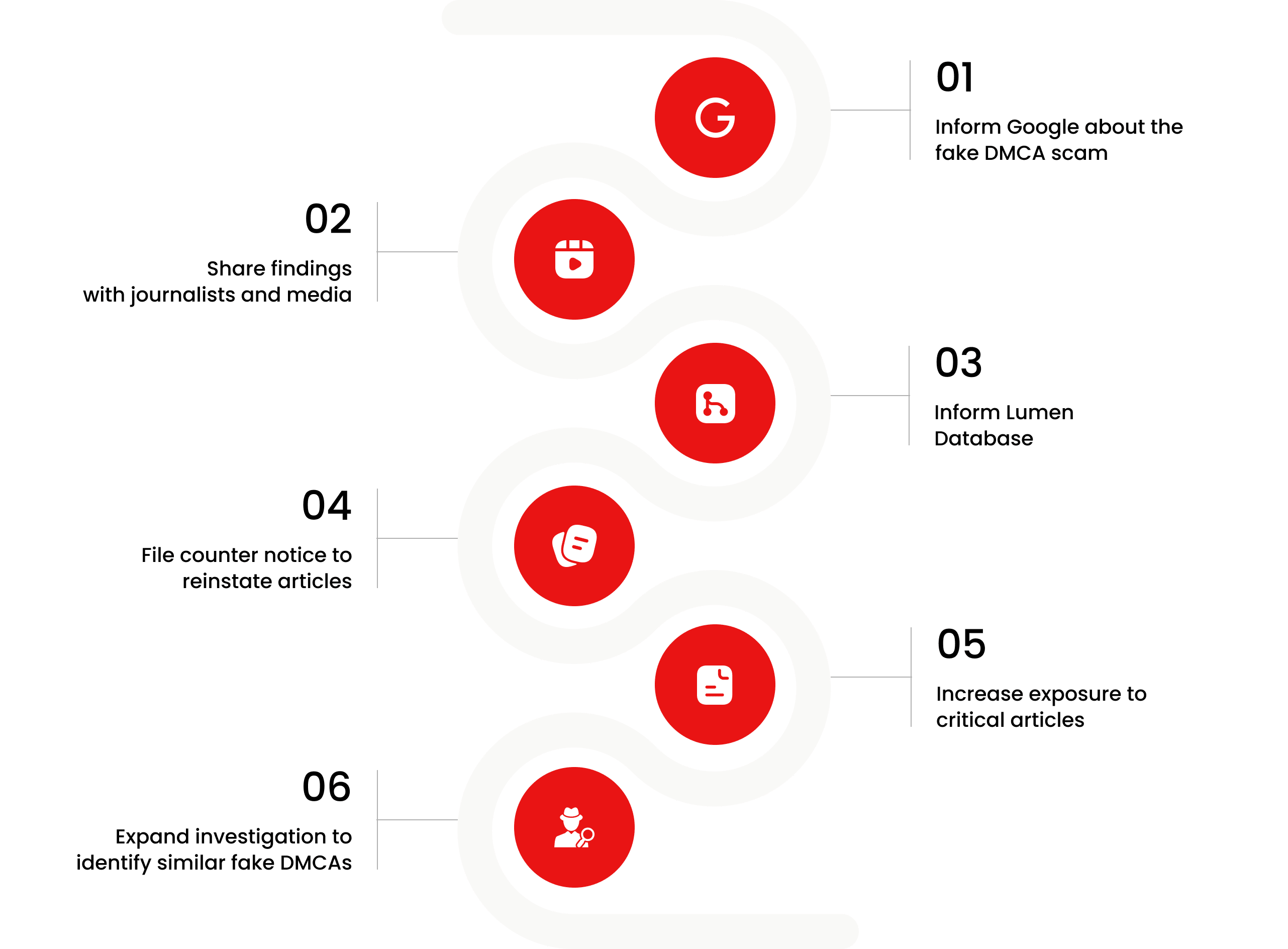

You are Never Alone in Your Fight.
Generate public support against the ones who wronged you!




Recent Investigations
Vintax Rent
Investigation Ongoing
Mansor Abdul
Investigation Ongoing
Max Josef Meier
Investigation Ongoing
User Reviews
Average Ratings
0
Based on 0 ratings
Website Reviews
Stop fraud before it happens with unbeatable speed, scale, depth, and breadth.
Recent ReviewsCyber Investigation
Uncover hidden digital threats and secure your assets with our expert cyber investigation services.
Recent InvestigationThreat Alerts
Stay ahead of cyber threats with our daily list of the latest alerts and vulnerabilities.
Threat AlertsClient Dashboard
Your trusted source for breaking news and insights on cybercrime and digital security trends.
Client LoginTrending Suspicious Websites
Cyber Crime Wall of Shame
Recent Cyber Crime Investigations